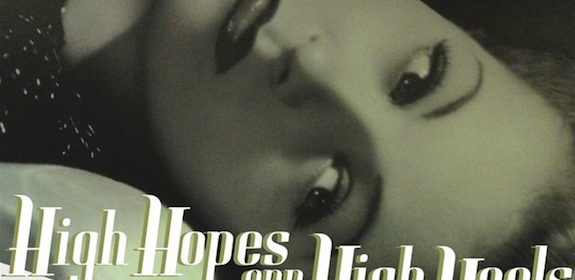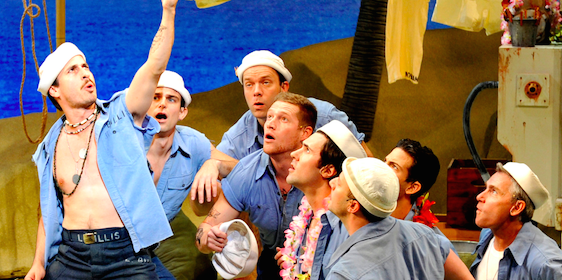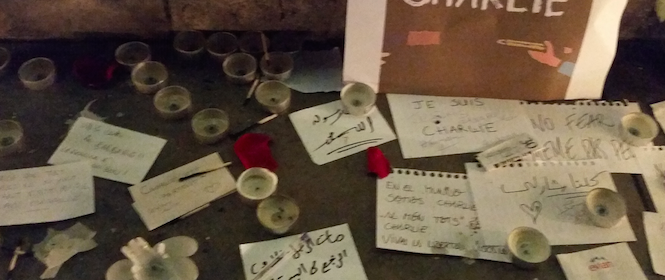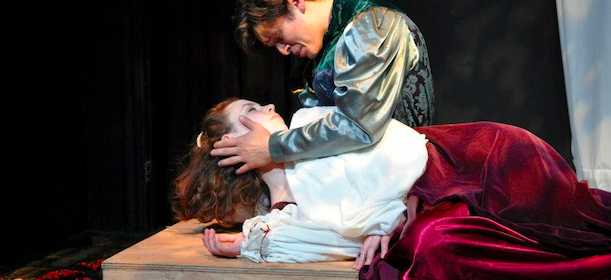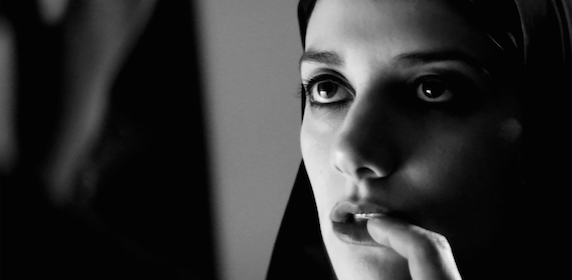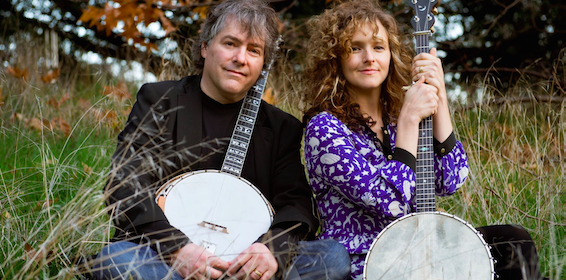TALKIN’ ABOUT ECOSEX—IN ART, THEORY, PRACTICE AND ACTIVISM

A conversation with Elizabeth Stephens, Annie Sprinkle and Kara Rooney
[editor’s note: Annie Sprinkle is an artist and a feminist adult film star with a PhD in human sexuality. She and her life partner and collaborator for 13 years, filmmaker Beth Stephens, came to Bloomington as guests of the Kinsey Institute for the fall show, “For Love or Money,” Kinsey. Some of Annie’s photographic artwork was included in the exhibition. Both Annie and Beth were featured guests at the Sex Salon and their film, Goodbye Gauley Mountain–An Ecosexual Love Story, was screened at IU.“Our film is about the tragedy of mountain top removal mining,” Beth says, “and it is also a love story about the Appalachia Mountains and the people who live in them.” It has screened at international film festivals and major museums; it’s still making the festival rounds and soon it will be released for pay per view by the distributor, Kino Lorber. Sprinkle and Stephens are “so totally thrilled to show the film at IU.”Stephens’ family has worked in mining since the 1600’s beginning in Cornwall, England. Born in Montgomery, West Virginia, she says she was raised to marry into the coal business. Instead she moved to California, became an artist and professor at University of California, Santa Cruz, and married Annie. The two women produced, directed, and star in the film together.
Goodbye Gauley Mountain was three years in the making. This documentary introduces some surprising moments, such as a wedding to the Appalachian Mountains and the gals singing the state song to the police. Earth First Journal’s Russ McSpadden writes, “Without compare, this is the sexiest nature documentary and one of the most profound films to deal with the beauty and tragedy of the Appalachian Mountains in the age of King Coal.”
“Our goal,” say the filmmakers, “is to spread the word about serious environmental issues, and also to make the environmental movement a little more sexy, fun and diverse.”]
KARA: Lets start with one of your art projects. You two did a series of nineteen weddings as performance art in nine countries. How do you bring a very private or intimate experience such as a wedding ceremony and its associated connotations into the public sphere, and what was it like to share those encounters for the first time with an audience?
BETH: We started doing the weddings as a form of protest, because it pissed us off that we weren’t allowed to get legally married. Not that we wanted to. It just wasn’t fair.
ANNIE: We had both done a ton of work about sex, so we wanted to try being ‘radically traditional’ and explore ‘love’ in a non-Hallmarky way. Our weddings were big love fests, which were quite humorous and irreverent, of course.
BETH: We married the Earth and other nature entities; rocks, soil, the sea, the sky, a lake in Finland…. Our first wedding was at the Harmony Burlesque theater, which was a lap dancing place on Broadway just below Canal street.
ANNIE: We had about 120 people there. We started out small. We sent out invitations and asked for no material gifts but invited people to help co-create the weddings. We had a procession, then about 20 3-minute performances; then the vows, the rings, the kiss, recession, and a ‘reception’ with more performances. When we got to the part where the officiant says, “does anyone object to this marriage,” our friend Barbara Carrellas objected. She hates weddings and marriage. So every wedding there after always had a couple of people perform objections to the marriage. When we did the kiss at the first wedding, we activated a tesla coil.
BETH: We wanted to do our first wedding of the series in Manhattan, even though we were living in California at the time, because that’s where we met, and where we both started our art careers. It’s where a lot of our close friends and former lovers were. Annie did her first one-woman show at the Harmony Burlesque, so the theater had sentimental value. Plus, it was in 2003 and not that long after 9/11.
ANNIE: Our friend, artist Sheila Pepe, described that first wedding as, “Broadway meets Fluxus in a whorehouse.”
KARA: The first wedding took place relatively soon after 9/11. Was that a coincidence, or were these performances meant to act as group healing sessions in some regard?
ANNIE: When the war in Afghanistan broke out, we thought, “hell, we can get along, let’s just make a commitment to work things out if there’s conflict. If we as individuals can’t work things out, how do we expect countries to get along?” We felt the personal was political, and that we were going to set an example somehow. But it was also a call for love; it was about wanting to generate more love in the world. We definitely wanted to bring some love to Manhattan after 9/11.
BETH: There were three different impulses that came together to create the wedding performances. The first one was that Annie and I got hitched up in a domestic partner ceremony so that Annie could get some health insurance.. I had a job as a professor, with benefits, so it was like sharing health insurance. Then the war in Afghanistan broke out. We realized that the wedding ritual was a great platform for transmitting a message, a feeling, a performance, whatever. At our domestic partner ceremony the press was there and we spoke out against the war and we were on the news all over the USA. If you present something as a special ritual, people seem to pay more attention.
KARA: Would it be accurate then to say that these performances acted for each of you as a therapeutic vehicle, or was this curative element a byproduct of their production?
ANNIE: We have done seventeen of the big weddings and only three were about people, the rest were about marrying nature. So for me, I always wanted to feel more connected with nature. I grew up in LA, lived in Manhattan 22 years, then San Francisco… The ecosexual weddings definitely connected me with nature. We have a video that is ten minutes long that shows highlights from some of our weddings. You can watch it on this web page: http://gauleymountain.com at the bottom of the page.
BETH: That’s where we first became really involved in environmentalism. We thought if there were a way to heal the earth that incorporated the kinds of issues we are looking at, and if people are part of the earth (people are nature) – then we would like to heal that binary system that separates people from nature.
ANNIE: If you think about it, people really are made of water, minerals, even stardust! So if people are made of the stuff of the Earth, therefore they are Earth. So when we married the Earth, that shifted everything for us. We followed our muses and ended up exactly where we are supposed to be today: developing ecosex art, theory, practice and activism. We’re trying to make the environmental movement more sexy, fun, and diverse, and make it a place for queers, sex workers and weird performance artists to feel comfortable. Hey, we don’t all fit into the Sierra Club. We hope our film, Goodbye Gauley Mountain—An Ecosexual Love Story entices other people to love the earth more.
Beth: We started shooting our next film, which is about water issues in California. Working title is Water Makes Us Wet. There’s more info at www.theEcosexuals.org.
KARA: This question of who profits or who benefits has been at the heart of the feminist debate, especially around the sex industry, for quite some time. In opening the picture up, you’ve taken that binary way of looking at the system of exploitation versus empowerment, or oppression versus liberation, out of the equation. You’re moving the conversation beyond these poles, presenting something very different in that regard.
ANNIE: To a lot of Americans, sex is about what sex toys you have, what lingerie you wear, what porn you have. Some people think you can’t have great sex unless you have the right strap-on. As ecosexuals we want to send a post consumerist message. We’re even saying “Stop making and watching porn! Let’s bring back the live sex show! Porn watching is using up so much electricity.” To be honest, I still do love lingerie and strap-ons. But that’s not the be-all end-all. There’s a whole world out there!
KARA: Annie, what you were saying before about the sex industry and its commodified entrenchment, in many ways it can be argued that the technological models we utilize mirror our relationship and needs to art, that our contemporary comfort zones are now to a large degree located either behind or in front of the camera instead of face to face. In your opinion, how does the sensibility of this mediated interface effect the consumption of erotica, porn, art, and other spheres of aesthetic or sexual interest?
ANNIE: From a historical perspective, human sexuality changes and goes through phases and has popular and unpopular styles. I believe everyone is at the right place at the right time. With the Internet, we are definitely exploring and discovering really interesting new territory. Who is to judge what’s better or worse, having computers or not? Now I’ll contradict myself. I’d argue that its important to keep making porn, because is it’s kind of an historical record. If you look at porn from the 1800s or the 1920s, sex was different then. Even blow job techniques change. Each person is an erotic universe unto themselves. We all have more to learn, and we all have something to teach. That’s what is so great about sex as subject matter, its endless, and there’s more to discover and create.
KARA: So this mediated interface does not affect the way that you approach your work or the consumption and reception of it? Whether it’s face-to-face or encountered via the television screen or the computer monitor, it’s –
ANNIE: It’s definitely best to experience our work live, in a group, to actually come with us for a weekend ecosex workshop and camp out and participate and interact with nature.
BETH: But ecosex includes technology too. We do love our social networking interfaces.
There is something ecosexy about computers, and ecosexy about cities too.
KARA: Annie, can you speak to how your prior experiences in the sex industry and the way that technology might have been used in those settings is different or is similar to the way that it’s used in the art world now? Perhaps not in your performances per se, but in other performances that you’ve been a part of, or that you’ve been witness to.
ANNIE: I totally loved combination of having sex and at the same time, shooting a film. It’s a great combo. Sex and creativity are so linked, They are one and the same impulse. With sex, and with creativity, or technology, some days are better than others, some days you just don’t go very far. Sometimes you’re a lead balloon going nowhere, and sometimes you fly. In our last theater piece, Earthy; an Ecosex Bootcamp, we use technology, video, lighting, and computers, to give the impression we are out in nature! That’s crazy. After we did that show, we redid it, we got another director and took it outside and made An Ecosexual Walking Tour which we just performed in June and will do in Central Park on September 16th. Much nicer to do a show about nature outside,
KARA: In terms of the way that you’re engaging with nature, especially in regards to your more recent work, there seems to be an invocation of the goddess in the texts that you’re employing and your physical presentation of self —
ANNIE: If anything, we think of the Earth as transgendered, actually multigendered – we’re not so into “lesbian” either. The word and concept of “lesbian” and “goddess” seems old fashioned, sort of quaint and nostalgic.
BETH: We’re definitely going with more of a punk rock edge these days.
ANNIE: The idea of having making love only with people seems really limiting, when you can make love with a tree, a rock, the ocean… So even this idea of “heterosexual” or “lesbian” or even “bisexual” – bisexual? Why only two? It all seems very limiting compared to what we imagine, which is a transgendered ginormous Universe with, gazillions of erotic and sensual possibilities.
BETH: It’s not just transgender, it’s transgenital.
ANNIE: Yeah, its totally beyond genital sex! But it includes genital sex of course. We love genital sex too. All sex is really ecosex!
BETH: I think a lot of strategies and tactics towards different kinds of political liberation have been viewed as having a narrow horizon – the horizons have narrowed for certain things, and I think with ecosexuality we’re really opening up the spaces of hopefulness that something else could move in a different way because we’re politically very clear about what we’re trying to do. We’re really trying to shift this metaphor around the Earth from ‘Earth as mother’ to ‘Earth as lover,’ to get people to engage in a more mutual way of being in and thinking about the world. But we’re not punitive, you know? We’re not “you’re either with us, or against us”. You can still maintain your heterosexuality and be ecosexual, or gayness, or your bisexuality and be ecosexual – it’s not an exclusive sexuality. It’s also not an exclusive viewpoint of the world. We hope our kind of ecosex engenders more passion, empathy and intimacy with nature, but also a wider vision as opposed to a narrow, gathered vision.
KARA: You’re not requiring people to identify with one state of being in the world; you’re actively challenging those codified norms.
BETH: Yeah, it’s really a campaign of attraction; if you want to be part of it then hey,
everybody’s welcome, but if you don’t, that’s fine too, bye bye.
* Kara Rooney is an artist and critic based in New York, where she currently serves as the Managing Art Editor for The Brooklyn Rail.


